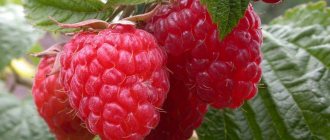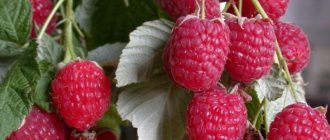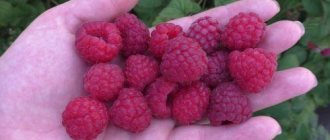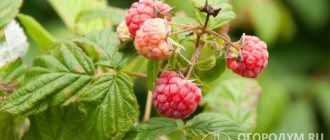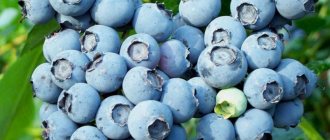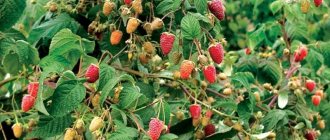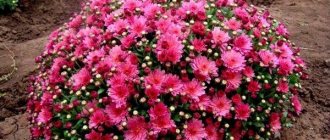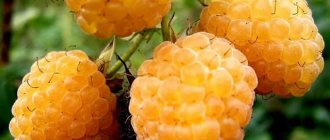Inaccessible is classified as an early ripening remontant variety. This raspberry is distinguished by its high productivity, long fruiting period, sweetness and relative ease of cultivation. Inaccessible bushes are often used as an unusual landscape decoration when creating a modern garden plot design. The variety was bred by the famous Russian breeder V.V. Kichina in 1988, until 1992 it was listed under the code name P34, this name is much less common, but is also found in reviews of gardeners.
Description of the variety
Inaccessible raspberry belongs to the remontant varieties, so its fruiting begins earlier than all other varieties of this berry crop; the first ripe berries on the bushes of this raspberry appear in the last days of July - the first days of August.
The fruiting period of this variety lasts until the onset of cold weather, so its name justifies itself - no other raspberry variety can “boast” of such a long fruiting period.
The bushes of this berry crop have to be harvested approximately once a week, resulting in up to 7 waves of fruiting over the entire season.
The height of the shoots of this raspberry rarely reaches 1.1-1.3 m. The maximum height of the bushes of this variety can be about 1.55 m; such a height can only be achieved if all the rules for caring for the plantation of this raspberry are followed. Bushes in width can reach a diameter of 0.7 m.
Therefore, you should not pay attention to the small size of seedlings of the Inaccessible raspberry variety and you need to remember that an adult shrub will also not be large in size, but flowers and berries will be located along the entire length of the shoots.
On the current year's shoots, the internodes are shortened, have no waxy coating, and small thorns are located along the entire length of the stem. At rest, the color of the shoots is brown with a yellowish tint.
Each raspberry bush produces up to 7 replacement stems, as well as about 10 root cuttings, so there will always be enough material for propagation of this variety. The shoots are quite well leafed. The foliage is quite large, on the outside it is bright emerald in color, slightly wrinkled, there are small jagged edges, there is no pubescence. On the reverse side, the color of the leaf plates is lighter.
Inflorescences and fruits begin to form and ripen from the top. The flowers are collected in inflorescences, each of which contains up to 4-7 berries. About 2-4 lateral branches are formed on the shoot, on which many fruit branches are formed. The length of the fruiting tip is about 0.9-1.1 m.
Raspberry Unattainable: care
Raspberry Unattainable is not demanding. This shrub does not require special care. However, you still need to know some features. Then a rich harvest of large and sweet berries is guaranteed.
- The plant does not need to be tied up.
- If there are branches that have a very large number of berries, you can install supports and secure the shoots to them.
- Inaccessible raspberries can produce two harvests per season.
- If you plan to grow it specifically for this purpose, then you need twice as much fertilizing.
- If you expect to get a harvest only once, then you can rest assured of its quality. It will be great.
Trimming
Pruning activities directly depend on the amount of harvest.
- If you intend to pick berries twice a year, then pruning should be done in the fall. All shoots need to be cut off. Except for the youngest, who are no more than one year old.
- In spring, the bush should be checked for severely damaged branches. They are also removed.
- In the case of obtaining only one harvest from a bush, pruning is done only closer to winter.
When pruning raspberries, you need to cut off all the shoots completely; they should not be above the surface of the ground, they should not be visible at all.
Watering
Watering raspberries of this variety should be taken especially seriously. Moistened soil will influence yield results. Carefully monitor the condition of the soil. As soon as you notice that it is starting to dry out, start watering.
It is worth watering the plant a little more often during the blooming of flowers and the appearance of berries. In autumn, the shrub also needs to be watered.
Top dressing
Raspberry Inaccessible is quite demanding on the composition of the soil. If the soil does not contain enough nutrients, this can have a bad effect on the quantity of the harvest and the quality of the fruit.
In total, it is necessary to fertilize raspberries three times during the season:
- It is worth starting in early spring. At this time, it is recommended to use complex fertilizers containing potassium and phosphorus. During this period, the saturation of the soil with nitrogen is important for the plant.
- As soon as the buds of inflorescences are visible on the shoots, a second feeding follows. In this case, fertilizers based on potassium sulfate are needed.
- At the end of the season, organic fertilizers are applied.
Experienced gardeners recommend ash as a fertilizer.
Preparing for winter
Among other things, the Inaccessible raspberry needs to be prepared for winter. To do this, the bush is cut to the surface of the ground. Then covered with peat or wood shavings. Please note that the layer must be at least 10 cm.
Gardeners do not recommend covering raspberries with hay, since it can harbor rodents. However, if raspberries produce two harvests a year, then they are not pruned for the winter.
Then you need to secure the shoots close to the ground and cover them with dense material. For example, roofing felt. If snow falls in late autumn, you can cover the bush with it. Preferably in a thick layer.
Pests
The most common raspberry pests are:
- Raspberry stem fly. This small insect damages the stems and leaves of raspberries. It can be recognized by its gray color and size of approximately 5-6 mm. To prevent damage, you need to carefully inspect the upper leaves. If pest larvae are detected, they must be cut off immediately;
- Raspberry beetle. This insect lays eggs in flower buds. If flowering has not yet begun, you can use special products. Also dig up the soil to a depth of approximately 20 cm;
- Raspberry stem gall midge. This pest looks like a small mosquito. It has a size of about 2 mm. Causes damage to bark and stems. Control measures include treatment with special means and pruning of affected shoots.
To avoid losing most of your crop due to harmful insects, use simple prevention methods:
- Annual digging of soil in the autumn;
- After pruning, the removed branches are taken away from the bush and burned;
- Carefully inspect the buds;
- Don't hesitate to collect fallen leaves;
- Remove root growth regularly;
- Inaccessible raspberries should not be planted next to other varieties of this crop.
Diseases
The most common diseases include:
- Gray rot. A gray coating appears on the bush. It needs to be treated with special chemicals. Prevention - moderate watering or laying a drainage layer;
- Anthracnose. This disease affects the foliage, it becomes dark and covered with spots. Special solutions will help. To avoid disease, you need to regularly thin out raspberries and remove weeds;
- Chlorosis. There is no point in fighting this disease. Such a bush should be removed; it cannot be saved. To save raspberries from the appearance of this disease at the very beginning of spring, special spraying solutions are used.
If you choose Inaccessible raspberries for your garden, you will undoubtedly receive a stable harvest of incredibly tasty berries. In addition, you do not have to use special methods to care for the plant.
Features of the fetus
The shape of ripe berries is conical, slightly elongated, the tip is slightly flattened. The color of the fruit is dark ruby, with a characteristic shine. On average, the weight of the fruit reaches 5-7 g, with good care they can reach 9-9.5 g. The length of the berries can reach 3.5-4 cm. The presentation of the berries is very attractive.
The tender juicy pulp contains practically no drupes, which are imperceptible in food. Therefore, Inaccessible raspberries are distinguished by their dessert taste and delicate fruity aroma.
But ripe berries are not held together too tightly, so they can fall apart when picked. Because of this, many summer residents say that the harvested crop does not tolerate transportation over different distances very well.
The fruits of this remontant raspberry are distinguished by their versatility of purpose - they are consumed fresh, added to desserts, prepared into preserves, jams, and frozen for the winter.
Main characteristics
This raspberry variety grows and bears fruit best in mild climates, without intense heat or heavy rainy seasons. During periods of extreme heat, the bushes slow down, and the berries bake and dry out. During the rains, the berries do not have time to accumulate the required amount of sugars, so they become too sour.
But the positive qualities of the variety include high resistance to frost, so this variety does not freeze out in regions with short, cool summers and harsh winters.
Productivity
With proper care of the bushes of this remontant raspberry, up to 6 kg of ripe produce is collected from each bush. But many gardeners say that if you do not apply too much fertilizing, then each bush produces at least 3 kg of raspberries per season.
Diseases and pests
Gardeners who grow these remontant raspberries on their plots do not have a clear opinion about the resistance of this variety to diseases and pests. But they all agree on one thing: if you grow raspberries as annuals, cut off all the shoots at the root every fall, remove all plant debris and fallen leaves, dig up the soil so that pests and pathogenic microorganisms have no place to hide for the winter.
Advantages
The main positive qualities of the remontant raspberry variety Inaccessible include:
- extended fruiting period - from the end of June until the first frost;
- the bushes are compact, so more plants of this variety can be grown on one square meter, thereby increasing the yield from a given plantation;
- good appearance of the fruit and excellent taste.
Flaws
- bushes of this variety do not tolerate heat well, so when growing this variety in the southern regions, this raspberry plantation should be shaded;
- if the soil lacks nutrition and light, the shoots may undergo chlorosis;
- the berries are not very well adhered to by drupes, so they do not tolerate transportation well;
- Bushes of this variety produce a large amount of shoots, which are not always needed in such quantities.
Reproduction
Growing this raspberry variety on your plot will not be difficult. Inaccessible annually produces a large increase in young shoots. However, it is propagated not only by seedlings; propagation of the crop by root cuttings is no less common.
- Planting purchased seedlings
For growing raspberries using this method, powerful planting material with a well-developed root system is suitable.
The bushes are deepened 6 cm deeper than the level of their previous growth. This is done in order to sprinkle the growth point. Seedlings are placed in pre-prepared trenches or holes. After planting, water the raspberries well to ensure that the soil adheres tightly to the rhizomes.
- Propagation by root suckers
Strong shoots are dug up along with part of the root of the mother plant. It is advisable to leave at least 30 - 40 cm of root. The offspring is planted in a well-fertilized place for rooting and further growth. Many gardeners prefer to plant root suckers in the spring. Taking into account the fact that the variety is remontant, by autumn you can get the first harvest from a young bush.
- Propagation by root cuttings
A more complex propagation method than propagation by root suckers. The essence of the method: a raspberry bush is dug up, extracting several roots at least 2-5 mm thick, optimally about the size of a pencil. Then the roots are divided into small cuttings 8-10 cm long. The latter are planted in a prepared place, to a depth of about 10 cm, and watered thoroughly.
Landing
Inaccessible raspberry is very demanding on the quality of the soil in which it is grown, so you need to think about applying fertilizing when preparing a site for planting seedlings of this variety.
Usually, when planting raspberries in the spring, trenches with fertilizers begin to be prepared in the fall. Trenches are dug to a depth of approximately 2 shovels, and a mixture of organic matter and complex mineral fertilizers is added to a depth of 1 bayonet.
Bushes should be planted in a row at a distance of 0.65-1.2 m from each other, and the row spacing should be at least 1.6-2.0 m.
Feeding
You need to remember to apply fertilizers throughout the growing season, because the yield of bushes during the season directly depends on the amount of nutrients in the soil.
You should not apply too much fertilizer containing nitrogen during the season - this mineral promotes the active growth of vegetative mass to the detriment of flowering and fruiting. It is better to use wood ash for this berry crop, as well as mineral fertilizers that contain phosphorus and potassium.
It is also good to cover the soil around the raspberry bushes with compost or humus mulch after watering. The thickness of such a layer should be at least 6-8 cm.
Although it seems that the shoots of this variety are not very tall and therefore do not require gartering, it is better to garter raspberries on trellises so that the bushes receive better sunlight, make it easier to care for, as well as regular harvesting.
Preparing for winter
If raspberries are planted in open ground in the spring, and they have not yet bear fruit in the current season, before the onset of cold weather, the shoots are untied from the trellises, tied together, bent to the soil and covered with spruce branches, and on top - with any non-woven material.
When growing Inaccessible raspberries in the Urals, Siberia or other regions with similar climatic conditions, after autumn pruning of plants, the plantation is covered with roots to prevent the root system from freezing during the harsh winter.
If cold weather occurs in the region already at the beginning of autumn, then raspberry bushes with fruits that have not yet ripened are covered with a breathable covering material so that the last fruits have time to ripen on the bushes.
Watering
Raspberries need to be watered moderately. This culture is afraid of large amounts of moisture.
How to do this:
- First you need to make sure that the soil is dry to a depth of 5 cm.
- Then watering is done.
- Finally, you need to loosen the soil and remove weeds.
Reference. One bush will need no more than 15 liters of water. If the planting is in trenches, then you should not pour more than 40 liters per square meter. To prevent moisture from spilling outside the raspberry tree, you need to make small furrows up to 15 cm deep. Then the water will accumulate in them and go underground to nourish the root system of the plants.
Reviews
Olga, 55 years old, Belgorod : we constantly grew raspberries on our plot, we tried many different varieties, but in the last few seasons we have only grown varieties bred by the breeder Kichina. All of them have good yields and do not require intensive care. Three seasons ago, Unbending raspberries were planted on the plot. This variety amazed us with its long fruiting. We collect the first berries in mid-July, and the last harvest is harvested at the end of October. In total, each bush produces at least 4.5-5 kg of ripe produce over the summer. But for this it is necessary to apply fertilizer to the bushes during the summer; for normal fruiting they need more nutrition than ordinary varieties.
Katya, 49 years old, Tver : Inaccessible raspberries have been growing on my plot for the fifth season. They planted it in the fall, the next season the yield of the variety was not too high, and the fruits themselves were a little sour - apparently, it was due to the fact that the summer was rainy. For the winter, the bushes were cut out and the plantings were covered with agro-canvas to prevent the roots from freezing. In the following seasons, the berries were larger, and the taste of the berries was better.
Pests and diseases
Raspberry Unattainable has excellent immunity. She is almost not susceptible to any diseases.
However, as a result of improper watering, various problems periodically arise:
- root rot;
- powdery mildew;
- gray rot;
- anthracnose
In most cases, using fungicides is sufficient to get rid of diseases. If nothing is done, the crop will survive, but the yield will be small. If the shoots are attacked by ants, aphids or other insects, then industrial poisons are used. They must be used according to the instructions so as not to harm the bush.
